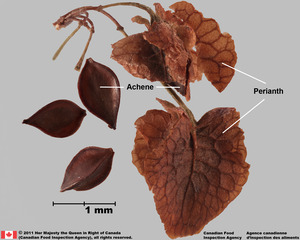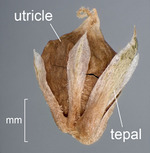Content is from Kirkbride et al. 2006Kirkbride et al. 2006:
Kirkbride JH, Jr, Gunn CR, and Dallwitz MJ. 2006. Family guide for fruits and seeds, vers. 1.0. Accessed September 2020-January 2022. URL: https://nt.ars-grin.gov/seedsfruits/keys/frsdfam/index.cfm ., without modification.
Updates are forthcoming.
Fruits: Pistil(s) simple; 1; 1-pistillate. Fruit pericarpium, or anthocarpanthocarp:
simple or compound and including some tissue of non-ovarian origin (accessory tissue) ; simple, or compound; acheneachene:
; simple, or compound; acheneachene:
a dry, indehiscent, one-seeded fruit, with seed attached to pericarp at a single point, derived from a single, superior, simple or compound, one-loculed ovary (acheneachene:
(acheneachene:
a dry, indehiscent, one-seeded fruit, with seed attached to pericarp at a single point, derived from a single, superior, simple or compound, one-loculed ovary & perianthperianth:
& perianthperianth:
collective term for calyx and corolla of a flower
 often disperse as a unit of most authors, not Spjut); achenosum (Spjut 4 families: Platanaceae, Rubiaceae, Sparganiaceae, Urticaceae); simple, or compound; acrosarcum, or diclesium, or glans; sorosussorosis:
often disperse as a unit of most authors, not Spjut); achenosum (Spjut 4 families: Platanaceae, Rubiaceae, Sparganiaceae, Urticaceae); simple, or compound; acrosarcum, or diclesium, or glans; sorosussorosis:
a multiple fruit composed of two or more fleshy fruitlets that developed on a peduncle
, or glandosum (Spjut Fig. 33E & 2 families: Nyctaginaceae, Urticaceae); without persistent central column; with styles(s); at apexapex:
the point farthest from the point of attachment, or the "tip" of an organ ; not within accessory organ(s), or within accessory organ(s); within perianthperianth:
; not within accessory organ(s), or within accessory organ(s); within perianthperianth:
collective term for calyx and corolla of a flower
 (becomes fleshy & stongly inflated or not), or tepalstepal:
(becomes fleshy & stongly inflated or not), or tepalstepal:
a member of the perianth, when it cannot be differentiated into a calyx and corolla (Utrica where inner tepalstepal:
(Utrica where inner tepalstepal:
a member of the perianth, when it cannot be differentiated into a calyx and corolla enlarge & outer tepalstepal:
enlarge & outer tepalstepal:
a member of the perianth, when it cannot be differentiated into a calyx and corolla remaining small), or calyxcalyx:
remaining small), or calyxcalyx:
the outer whorl of the perianth; all the sepals of a flower , or hypanthium; accrescentaccrescent:
, or hypanthium; accrescentaccrescent:
growing continuously
; persistent; soft calyxcalyx:
the outer whorl of the perianth; all the sepals of a flower ; with hypanthium achenes; 1-seeded; 1-seeded; with 1-carpellate; not sulcatesulcate:
; with hypanthium achenes; 1-seeded; 1-seeded; with 1-carpellate; not sulcatesulcate:
surface relief—having one or more elongate, relatively narrow and shallow depressions or grooves ; in transection flat, or compressedcompressed:
; in transection flat, or compressedcompressed:
flattened; in grasses, used to denote compression (not necessarily flattened) either laterally or dorsiventrally
; apexapex:
the point farthest from the point of attachment, or the "tip" of an organ beaked; apexapex:
beaked; apexapex:
the point farthest from the point of attachment, or the "tip" of an organ short beaked; wall thin walled; indehiscentindehiscent:
short beaked; wall thin walled; indehiscentindehiscent:
not opening on its own, as in a fruit
 . Epicarpepicarp:
. Epicarpepicarp:
outer layer of fruit wall or pericarp, if divided into layers; note here used synonymously with exocarp black, or brown (all shades); shinyshiny:
black, or brown (all shades); shinyshiny:
uniformly reflecting a high proportion of incident light at all angles , or dulldull:
, or dulldull:
reflecting only a low proportion of incident light, with no apparent sheen ; durable; chartaceouschartaceous:
; durable; chartaceouschartaceous:
papery, papyraceous
; glabrousglabrous:
without hairs
, or not glabrousglabrous:
without hairs
(with hairs); hairs short; hairs not glandularglandular:
surface relief—covered with small, raised secretory glands, regular or irregularly shaped, translucent or opaque, and maybe distinctly colored ; without armature; smooth, or not smooth; papillosepapillate:
; without armature; smooth, or not smooth; papillosepapillate:
surface relief—bearing minute, distinct, broad-based projections, tapering to a rounded apex (or covered with prominent bosses for Pilea); without wing(s); without apicalapical:
(or covered with prominent bosses for Pilea); without wing(s); without apicalapical:
at or pertaining to the end of the seed or fruit distal from its point of attachment (i.e., base)
respiratory hole. Mesocarpmesocarp:
the middle layer of the pericarp, if divided into layers present. Endocarpendocarp:
present. Endocarpendocarp:
the inner layer of the pericarp, if divided into layers present, or absent; not separating from exocarpexocarp:
present, or absent; not separating from exocarpexocarp:
outer layer of fruit wall or pericarp, if divided into layers; note here used synonymously with epicarp ; thin, or hard; not splitting into 1-seeded pyrenes; stone unilocular; smooth; without wing; without operculumoperculum:
; thin, or hard; not splitting into 1-seeded pyrenes; stone unilocular; smooth; without wing; without operculumoperculum:
a dehiscent cap (or lid) of a seed or fruit that opens during germination or dehiscence ; without secretory cavities; without mechanism for seedling escape; without longitudinallongitudinal:
; without secretory cavities; without mechanism for seedling escape; without longitudinallongitudinal:
of or relating to length or the lengthwise dimension
ridges. Funiculusfuniculus:
(alt. funicle) stalk connecting the ovule (later seed) to the ovary (later fruit) placenta short; short without seed bearing hookswith hooks:
short; short without seed bearing hookswith hooks:
bristles or spines with curved or backwards pointing tips, or with secondary bristles along their length (retinacula); not persisting in fruit after seed shed.
(retinacula); not persisting in fruit after seed shed.
Seeds: Arilaril:
(broad sense) appendicular structure that wholly or partly envelops a seed and is produced from or a modification of the funicle, raphe, or outer integument; usually fleshy or pulpy, sometimes spongy or tufted-capillate, often brightly colored absent. Seed larger than minute; ovateovate:
absent. Seed larger than minute; ovateovate:
2D shape—egg-shaped in outline, widest point is towards one end of the organ, the other end tapers gradually, attachment at or near the broad end (compare obovate, ovoid) ; in transection compressedcompressed:
; in transection compressedcompressed:
flattened; in grasses, used to denote compression (not necessarily flattened) either laterally or dorsiventrally
; not bowl shaped; not nutlike; without winglike beakbeak:
a usually firm, terminal appendage, sometimes tapered ; without caudatecaudate:
; without caudatecaudate:
tapering to a long, tail-like appendage appendage(s); at maturity with food reserves, or without food reserves (Elatostema), or without apparent food reserves; with endosperm; without canavanine. Sarcotestasarcotesta:
appendage(s); at maturity with food reserves, or without food reserves (Elatostema), or without apparent food reserves; with endosperm; without canavanine. Sarcotestasarcotesta:
pulpy or fleshy outer layer of the seed coat, simulates aril absent. Testatesta:
absent. Testatesta:
seed coat
 reduced present, or absent; vestigial (or reduced); without embryo surrounded and capped by viscid tissue. Endosperm development nuclear; scant, or copious (rarely); fleshy; opaqueopaque:
reduced present, or absent; vestigial (or reduced); without embryo surrounded and capped by viscid tissue. Endosperm development nuclear; scant, or copious (rarely); fleshy; opaqueopaque:
not transmitting light
(at least); smooth; with starch, or without starch; with oils; without fatty acid containing cyclopropene; without apicalapical:
at or pertaining to the end of the seed or fruit distal from its point of attachment (i.e., base)
lobes; without chlorophyll; without isodiametric faceted surface; without odor. Embryo differentiated from food reserve; well developed; 1 per seed; nearly filling testatesta:
seed coat
 (trace or scanty food reserve), or completely filling testatesta:
(trace or scanty food reserve), or completely filling testatesta:
seed coat
 (no food reserve); 0.9–1 times the length of food reserve; at one end of seed not extending into a depression or cup; axileaxile:
(no food reserve); 0.9–1 times the length of food reserve; at one end of seed not extending into a depression or cup; axileaxile:
on or of the axis
and centric; foliatefoliate:
appearing leaf-like
; with spatulatespatulate:
2D shape—like a spatula; rounded at the apex, with base long and tapered; (of embryo) embryo is straight and axile and centric with the cotyledons expanded to form the shape of a spatula or spoon; (of cotyledons) cotyledons expanded and wider than the stalk but not invested into the stalk cotyledons; straight; obliqueoblique:
cotyledons; straight; obliqueoblique:
in a slanting direction or position, neither horizontal nor vertical
to seed length; embedded in endosperm; with cotyledons abruptly connected to hypocotyl-radicle; without coleorhiza; without simmondsin; without stomata; not green; with 2 or more cotyledons. Cotyledons 2; well developed; 0.5–0.7 times length of embryo; somewhat to significantly wider than hypocotyl-radicle; 2–4 times wider than hypocotyl-radicle; not concealing hypocotyl-radicle; foliaceous; thin; flat; smooth; with apicesapex:
the point farthest from the point of attachment, or the "tip" of an organ entire; with margins separate; basally entire; equal in size; not punctatepunctate:
entire; with margins separate; basally entire; equal in size; not punctatepunctate:
surface relief - dotted with pits or with translucent, sunken glands or with colored dots, similar to pitted dotted. Hypocotyl-radicle moderately developed to well developed; straight; not thickened.
dotted. Hypocotyl-radicle moderately developed to well developed; straight; not thickened.
Spjut's glandosum (a fruit type) covers the compound fruit of aggregated fruitlets in which the bulk of the fruit is formed by accrescent peduncle, recepacle, or involucre. His example is Procris laevigata Blume but does this fruit meet his definition? Friis & Wilmot-Dear (1988): "Fruits are achenes with external organs of the perianth, pedicel or inflorescence, which at maturity form wings (accrescent perianth) or involucral bracts, or fleshy, accrescent perianth. Urtica "dispersed without a perianth". Laportea "dry unaltered perianth". Obelia "winged". Urera "accrescent fleshy perianth". Boehmerieae & Parietarieae "dry fleshy accrecent tubular perianth". Forsshaolae "persistent involucre". Achene and perianth occasionally disperse together.
Literature specific to this family: Miller, N.G. 1971. The genera of the Urticaceae in the southeastern United States. J. Arnold Arbor. 52:40–68; Friis, I. & C.M. Wilmot-Dear. 1988. A revision of the tribe Forsskaoleae (Urticaceae). Nord. J. Bot. 8:25–59; Friis, I. 1989. The Urticaceae: a systematic review. In: P.R. Crane & S. Blackmore, eds., Evolution, Systematics, and Fossil History of the Hamamelidae, vol. 2: 'Higher' Hamamelidae, pp. 285–308. Clarendon Press, Oxford.
General references: Corner, E.J.H. 1976. The seeds of Dicots, esp. vol. 2. Cambridge University Press, New York, Cronquist, A. 1981. An integrated system of classification of flowering plants, 1,262 p. Columbia University Press, New York, Gaertner, J. 1788–1805. De fructibus et seminibus plantarum. The Author, Stuttgart, Goldberg, A. 1986 (dicots) & 1989 (monocots). Classification, evolution, and phylogeny of the familes of Dicotyledons. Smithsonian Contr. Bot. 58 for dicots (314 pp.) & 71 for monocots (74 pp.). [Goldberg's illustrations are reproduced from older publications and these should be consulted], Gunn, C.R. & C.A. Ritchie. 1988. Identification of disseminules listed in the Federal Noxious Weed Act. Techn. Bull. U.S.D.A. 1719:1–313, Gunn, C.R., J.H. Wiersema, C.A. Ritchie, & J.H. Kirkbride, Jr. 1992 & amendments. Families and genera of Spermatophytes recognized by the Agricultural Research Service. Techn. Bull. U.S.D.A. 1796:1–500, Mabberley, D.J. 1987. The plant-book, 706 p. Cambridge University Press, Cambridge, Martin, A.C. 1946. The comparative internal morphology of seeds. Amer. Midl. Naturalist 36:513–660, Spjut, R.W. 1994. A systematic treatment of fruit types. Mem. New York Bot. Gard. 70:1–182, and Wood, C.E., Jr. 1974. A student's atlas of flowering plants: Some dicotyledons of eastern North America, 120 pp. Harper & Row, New York.